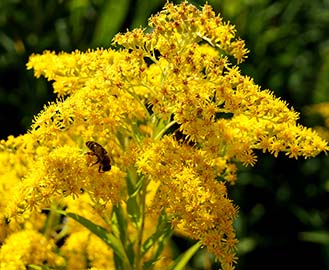 Goldenrod
Goldenrod
You may have noticed in your garden experiences that your hands or clothing became stained when working with plants. Who hasn’t gotten grass-stained knees at some point or berry-purple fingers? Well, those same plant staining properties can be turned from accident to purposeful usage with some basic dying techniques.
One of the hottest new gardening trends is cultivating plants for creating natural fabric dyes. It is another aspect of organic, authentic living. You grow your own food and herbs, you might raise your own sheep for fiber, creating natural plant dyes is just the next step in the DIY revolution.
You may already be growing many of these plants in your ornamental garden or vegetable plots, so there is no need to start from scratch or overhaul your whole landscape to start exploring natural plant dyes. Here is a short list of common dye plants that are fairly easy to grow along with the dye color you can create from each one.
 Lavender
Lavender
- Artemisia – green
- Beets – red
- Hibiscus flowers – maroon
- Lavender – pink
- Goldenrod – brown
- Iris roots – gray
- Marigold – yellow
- Onions – orange
- Oregano – black
The strength of pigment you end up with will depend on how long you soak the fabric, what the fibers are made from, and the dye concentration you create. You will also need to use a color fixative such as a salt water or vinegar bath so the dye does not wash out.
For further reading, check out these two new books on the topic: “A Garden to Dye For” by Chris McLaughlin and “Natural Color” by Sasha Duerr. Both books contain many beautiful and inspirational plant dye projects that are sure to get you dreaming of the fashionable possibilities you can grow in the garden next season.
By Kathy Jentz